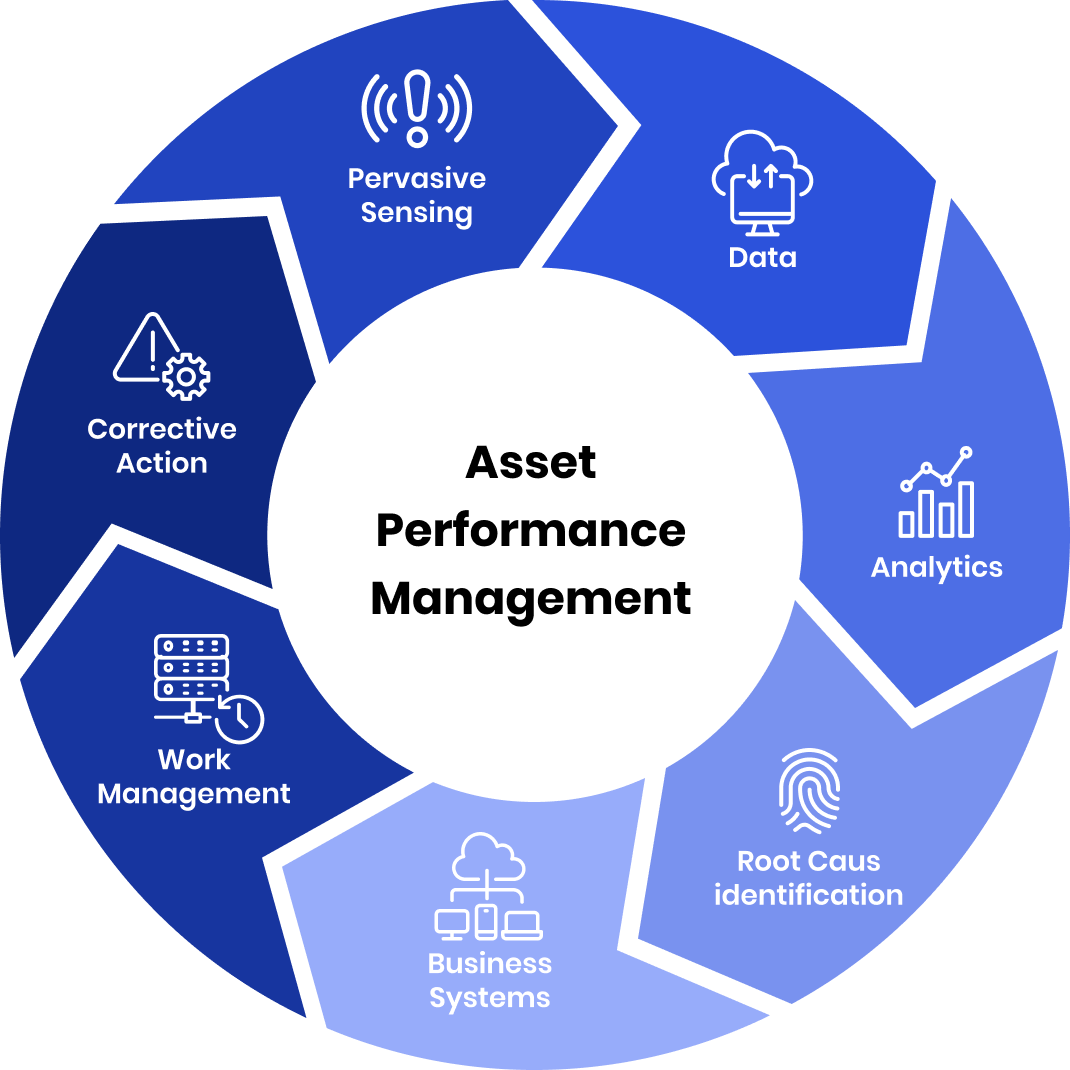Asset Performance Management (APM) is critical to any organization’s operational strategy. It is a holistic approach to managing the performance of the physical assets that are essential to a company’s operations. APM is a process that helps organizations to maximize the availability, reliability, safety, and efficiency of their physical assets. This blog will discuss the key components of APM, the benefits of implementing an APM system, and the challenges associated with utilizing APM.
Related article: What is Change Management?
What is Asset Performance Management (APM)
Asset Performance Management (APM) is a system used to monitor and optimize the performance of assets. It is used to identify and address issues that can degrade asset performance and reduce the cost of operation. It provides a holistic view of asset performance by monitoring, analyzing, and predicting performance to improve efficiency and cost savings.
APM uses a combination of sensors, software, and analytics to track and analyze data from assets over time. This data identifies potential problems before they become major issues and help to plan for maintenance and repairs. APM can also be used to improve asset reliability and extend the life of an asset. There are numerous benefits to implementing APM.
Benefits of Asset Performance Management (APM)
Asset Performance Management (APM) is a comprehensive approach to optimizing the performance of an organization’s assets. It is a process that combines all the elements of asset management, from design and maintenance to operations and analytics, to ensure that assets perform optimally and efficiently. As a result, APM can help organizations get the most out of their assets and reduce the costs associated with asset maintenance and operations. The benefits of APM include improved asset reliability, increased availability, better safety, reduced operating costs, and improved asset utilization.
- Asset reliability: APM can improve asset reliability by providing organizations with more accurate data and analytics. By gathering data from various sources, such as sensors, field personnel, and other sources, organizations can gain more detailed insights into their assets and identify potential issues before they become significant problems.
- Enhanced safety: Asset Performance Management (APM) helps identify and address potential safety issues before they become serious problems. It can reduce the risk of accidents and improve the overall safety of the workplace.
- Reduced operating costs: APM helps identify areas where operations can be streamlined or improved. It can lead to cost savings in labor, materials, and energy.
- Improved Equipment Performance: APM helps monitor and maintain equipment performance to be used more efficiently and reliably. It can reduce downtime and increase production.
- Total compliance: APM allows organizations to monitor their compliance with regulations and standards, which helps ensure that they adhere to their industry’s best practices.
- Improved visibility: APM gives organizations a comprehensive view of their assets and performance, helping them make informed decisions about their operations and make proactive changes when needed.
Asset Performance Management (APM) Drives Successful Asset Management
Asset Performance Management (APM) is a critical component of successful asset management. It is the combination of technology, processes, and practices used to monitor and manage the health and performance of assets over their lifecycle. It helps organizations understand the current condition of their assets, identify potential problems, and take proactive measures to optimize their performance.
APM enables organizations to make informed and cost-effective decisions about their assets. It provides visibility into asset performance and helps identify areas of improvement. APM also offers valuable insights into asset utilization, enabling organizations to decide when and how to deploy their assets.
By using APM, organizations can maximize their asset performance and minimize downtime. It can also help organizations detect and correct potential problems before they become costly. It enables organizations to maintain their assets in peak condition, reduce maintenance costs, and increase the lifespan of their assets.
APM also enables organizations to track and analyze their asset utilization, enabling them to identify improvement areas. It helps organizations to optimize their asset utilization and maximize the value of their assets.
Overall, APM helps organizations achieve a successful asset management strategy. It provides organizations with the tools and insights they need to maximize the performance and lifespan of their assets while minimizing downtime and maintenance costs.

What are the key components of Asset Performance Management (APM)?
Asset Performance Management (APM) is a strategic approach to managing physical assets such as machines, equipment, and systems to optimize performance, reduce downtime, and maximize useful life. The key components of APM are:
- Condition monitoring: Condition monitoring is a key component of APM. It is the practice of monitoring the condition of an asset over time to identify any potential problems before they become more serious. It includes monitoring vibration, temperature, pressure, flow, and other operational parameters.
- Predictive maintenance: Predictive maintenance uses data from condition monitoring to predict when an asset will require maintenance, further helping to reduce downtime and avoid costly repairs and replacements.
- Maintenance optimization: Maintenance optimization is the practice of scheduling maintenance and repairs in the most cost-effective manner. It includes determining the most cost-effective way to perform maintenance, when to perform it, and which parts and labor should be used.
- Asset performance analytics: Asset performance analytics is the practice of using data to identify trends, patterns, and correlations that can be used to improve asset performance. This includes using data to determine the root cause of problems, identify potential solutions, and identify areas of improvement.
- Performance management systems: Performance management systems are software systems used to monitor and manage asset performance. These systems integrate with other systems, such as condition monitoring and predictive maintenance, to provide a comprehensive view of asset performance.
These are the key components of Asset Performance Management (APM). By utilizing these components, organizations can optimize the performance of their physical assets, reduce downtime, and maximize their useful life. While there are benefits to implementing APM, there are also a few challenges that must be overcome.
Challenges associated with utilizing Asset Performance Management (APM)
The primary challenge associated with utilizing Asset Performance Management (APM) is that it requires a significant investment in time and resources. Companies must dedicate staff to the implementation and maintenance of APM systems, and they must also invest in the necessary hardware and software.
Additionally, APM requires collecting and analyzing a large amount of data, which can be costly and time-consuming. Companies must also ensure that their APM systems are regularly updated with the latest technology as new products and services become available.

Another challenge associated with APM is that it requires a high level of expertise to be correctly implemented and maintained. Companies must understand the nuances of the various systems and be able to interpret the data correctly. Moreover, the data collected must be accurate and up-to-date in order for the system to be effective.
Finally, APM systems can be challenging to integrate into existing enterprise systems, requiring additional resources and expertise. It can be a costly and time-consuming process, and it can require significant cooperation from various departments within the organization.
Overall, utilizing Asset Performance Management (APM) can be a complex process that requires a significant investment of time and resources and a high level of expertise. Companies must carefully weigh the costs and benefits of implementing APM and consider the potential risks before making any decisions.
Why should you implement Asset Performance Management?
Asset performance management (APM) is paramount to ensuring your organization achieves the best results from its assets. Implementing APM can help identify areas of improvement and optimization, allowing for the most effective use of your assets while reducing operating costs and improving asset utilization.
APM can be used to identify areas of efficiency and improvement in your asset management processes. It includes identifying areas where assets are not being used to their fullest potential, areas where maintenance and repair are required, and determining how to best utilize assets to maximize their effectiveness.
APM can also help to identify and eliminate any inefficiencies in asset management processes, such as delays in maintenance or repairs or unnecessary costs associated with asset management. By implementing APM, you can ensure that your organization is making the most of its assets while also ensuring that they are being used most effectively. This can reduce costs associated with asset management and improve overall asset utilization, resulting in an overall increase in efficiency and profitability.
By implementing APM, you can also ensure that your organization complies with regulations and standards and protect your assets and organization from potential liabilities.
Final Note
Asset Performance Management (APM) is a powerful tool that can help businesses and organizations better understand their assets’ performance. APM enables companies to track, analyze and optimize the performance of their assets, allowing for better decision-making and improved results. In addition, APM can help to identify potential weaknesses and areas for improvement. Ultimately, APM is an invaluable tool that can help businesses and organizations to maximize their asset performance and achieve greater success.


















